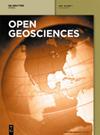中国准噶尔盆地红河断裂带中段页岩构造对石炭纪火山岩储层的影响
IF 1.3
4区 地球科学
Q3 GEOSCIENCES, MULTIDISCIPLINARY
引用次数: 0
摘要
本研究对位于准噶尔盆地西北边缘红河断裂带中部的CH471井区石炭纪火山岩储层进行了深入研究。通过地震资料和井位对比,我们仔细研究了构造演化模型,阐明了红河断裂带页岩构造对火山岩储层的影响。研究得出以下认识:石炭纪火山岩形成后,受洪切断层构造的影响,发生了一系列从延伸到挤压最后到推覆的构造叠加,导致火山岩体向西北倾斜,岩体内部产生了大量裂隙。同时,顶部被抬升,受风化和淋溶作用形成风化壳,最终形成储层。北部位于喷发中心的边缘地带,岩体分层较好。岩层对储层分布有一定的制约作用,储层沿岩体倾斜分布。南部靠近喷发中心,具有较大的火山角砾岩堆积体,内部异质性较强。储层主要发育在风化壳控制范围和致密断裂发育的叠加区,岩体形态不控制该区域。构造是形成火山岩储层的关键,主要体现在以下几个方面。首先,构造活动伴随着断裂发育,活动强烈的地区断裂密集发育,可以有效改善火山岩储层的物理性质。其次,构造活动导致地层抬升和风化剥蚀,形成风化壳。在风化浸染的控制范围内,火山岩的物理性质得到改善,更容易形成优质储层。第三,火山岩体的分布受构造活动控制,影响储层受主要岩性控制。本文章由计算机程序翻译,如有差异,请以英文原文为准。
Influence of nappe structure on the Carboniferous volcanic reservoir in the middle of the Hongche Fault Zone, Junggar Basin, China
This work presents an in-depth examination of the Carboniferous volcanic reservoir within the CH471 well area, situated in the central portion of the Hongche fault zone on the northwestern margin of the Junggar Basin. Leveraging seismic data and well connection comparisons, we scrutinize the tectonic evolution model and elucidate the impact of the nappe structure of the Hongche fault zone on the volcanic reservoir. The study has obtained the following understanding: after the formation of Carboniferous volcanic rocks, affected by the Hongche fault structure, a series of structural superpositions from extension to extrusion and finally thrust occurred, resulting in a northwestward tilt of the volcanic rock mass, and a large number of cracks were generated inside the rock mass. At the same time, the top was uplifted and affected by weathering and leaching to form a weathering crust, eventually forming a reservoir. The northern part is located in the edge area of the eruption center, and the rock mass has good stratification. The rock strata have certain constraints on the reservoir distribution, and the reservoir is inclined along the rock mass. The southern part is close to the eruption center and features large volcanic breccia accumulation bodies with strong internal heterogeneity. The reservoir developed mainly in the superposition of the range of control of the weathering crust and dense fracture development, and the rock mass morphology does not control the area. Structure is the key to forming a volcanic rock reservoir, mainly reflected in the following aspects. First, tectonic activity is accompanied by fracture development, and fractures are densely developed in areas with strong activity, which can effectively improve the physical properties of volcanic reservoirs. Second, tectonic activity leads to the strata uplift and weathering denudation, forming a weathering crust. Within the range of control of weathering and leaching, the physical properties of volcanic rocks are improved, and it is easier to form high-quality reservoirs. Third, the distribution of volcanic rock masses is controlled by tectonic activity, which affects the reservoir controlled by the dominant lithology.
求助全文
通过发布文献求助,成功后即可免费获取论文全文。
去求助
来源期刊

Open Geosciences
GEOSCIENCES, MULTIDISCIPLINARY-
CiteScore
3.10
自引率
10.00%
发文量
63
审稿时长
15 weeks
期刊介绍:
Open Geosciences (formerly Central European Journal of Geosciences - CEJG) is an open access, peer-reviewed journal publishing original research results from all fields of Earth Sciences such as: Atmospheric Sciences, Geology, Geophysics, Geography, Oceanography and Hydrology, Glaciology, Speleology, Volcanology, Soil Science, Palaeoecology, Geotourism, Geoinformatics, Geostatistics.
 求助内容:
求助内容: 应助结果提醒方式:
应助结果提醒方式:


